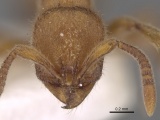Key to Palaearctic Proceratium Species
The following key to workers is based on Baroni Urbani, C., de Andrade, M.L. (2003) The ant genus Proceratium in the extant and fossil record (Hymenoptera: Formicidae). Museo Regionale di Scienze Naturali, Monografie, 36, 1–492.
The species Proceratium longmenense and Proceratium zhaoi occur in this region but are not included in this key.
1
- Lower mesopleura entirely inflated. Petiole and postpetiole with a posterodorsal transparent blister under the integument. Israel . . . . . Proceratium galilaeum
- Lower mesopleura not inflated. Petiole and postpetiole without a posterodorsal transparent blister under the integument . . . . . 2
2
return to couplet #1
- Petiole without neck and rectangular. Anterior clypeal border straight. First gastral tergite with a transparent macula close to the posterior border. Palp formula 2,2 . . . . . 3
- Petiole convex. Anterior clypeal border medially rectangular or triangular. First gastral tergite without transparent macula. Palp formula 4,3, 3,3 or 3,2 . . . . . 4
3
return to couplet #2
- Postpetiole very sparsely granulopunctate. TL 3.03-3.29 mm and petiolar width 0.27-0.29 mm. Tunisia, Algeria, Cyprus, Turkey and Albania . . . . . Proceratium numidicum
 Head of Proceratium numidicum worker |
 Lateral view of Proceratium numidicum worker |
- Postpetiole strongly granulopunctate TL 2.84-3.32 mm and petiolar width 0.30-0.35 mm. Japan, Taiwan . . . . . Proceratium japonicum
 Head of Proceratium japonicum worker |
 Lateral view of Proceratium japonicum worker |
4
return to couplet #2
- Propodeal suture well marked. First funicular joint about 1/2 longer than broad. Pakistan . . . . . Proceratium confinium
- Propodeal suture absent. First funicular joint at most 1/3 longer than broad . . . . . 5
5
return to couplet #4
- Clypeus medially strongly protruding anteriorly and rectangular . . . . . 6
- Clypeus medially protruding anteriorly but triangular . . . . . 8
6
return to couplet #5
- Propodeal lamellae absent. Head only weakly convex posteriorly. Integumental sculpture superficial. Malta and Sicily . . . . . Proceratium melitense
- Propodeal lamellae well developed. Head convex posteriorly. Integumental sculpture well marked . . . . . 7
7
return to couplet #6
- Mesosoma, petiole and postpetiole with deep sculpture. Body dark ferrugineous. Japan, Korea, Korea?, China? . . . . . Proceratium watasei
- Mesosoma, petiole and postpetiole with superficial sculpture. Colour light brown. Italy, Croatia, Greece, Algeria, Morocco and Tunisia . . . . . Proceratium algiricum
8
return to couplet #5
- Fore tibiae without basal spine. Second tarsomere of hind legs shorter than pretarsus. First gastral sternite protruding over the postpetiolar sternite. Japan, Korea?, China? . . . . . Proceratium itoi
 Head of Proceratium itoi worker |
 Lateral view of Proceratium itoi worker |
- Fore tibiae with basal spine. Second tarsomere of hind legs at least as long as the pretarsus. First gastral sternite not protruding over the postpetiolar sternite . . . . . 9
9
return to couplet #8
- Head granulate-punctate. Petiole slightly longer than broad. Second tarsomere of hind legs about as long as the pretarsus. Japan . . . . . Proceratium morisitai
 Head of Proceratium morisitai worker |
 Lateral view of Proceratium morisitai worker |
- Head reticulate-punctate. Petiole about as broad as long. Second tarsomere of hind legs about 1/5 longer than the pretarsus. Czech Republic, Hungary, Ukraine, Yugoslavia, Italy, Romania, Bulgaria, Albania, Greece, Turkey, Spain . . . . . Proceratium melinum
 Head of Proceratium melinum worker |
 Lateral view of Proceratium melinum worker |